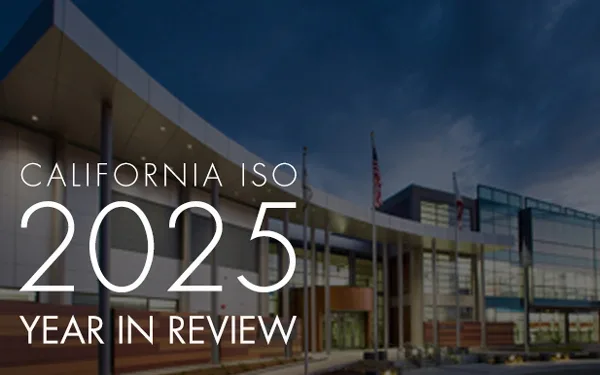FERC approves another key step toward independent governance of Western markets
The Federal Energy Regulatory Commission (FERC) has accepted a tariff amendment that will support the California ISO’s implementation of the “West-wide Governance Pathways Step 1” proposal, an important development toward independent governance of Western energy markets.
The change will modify the process to be followed if the ISO Board of Governors and the Western Energy Markets Governing Body disagree on a markets-related tariff proposal. The new tariff amendment would add, after other steps are taken in an attempt to reach agreement, an option to file two alternative proposals and allow FERC to decide between them.
Two other governance changes associated with Step 1 of the Pathways initiative have already been approved by the ISO’s Board of Governors and Western Energy Markets Governing Body and did not require FERC approval.
One will elevate the role of the Governing Body from joint to primary authority in approving proposed tariff changes for the ISO-managed wholesale electricity markets — both the Western Energy Imbalance Market (WEIM) and the Extended Day-Ahead Market (EDAM). The Governing body had primary authority until 2022 when its scope of authority was adjusted. The other change already approved by the two governing bodies will add new language to market governance documents reinforcing the interests of consumers in the decision-making process
Changes associated with the Pathways Step 1 proposal don’t take effect immediately. They will be implemented after the following conditions are satisfied, which is anticipated to occur later this year:
- Utilities representing at least 70% of the ISO balancing authority area load have executed implementation agreements for joining EDAM, and
- There is geographic diversity beyond those utilities that already have implementation agreements to include at least one non-California entity from the Pacific Northwest and the Southwest.
The tariff amendment approved by FERC addresses a situation that has not arisen in the decade since the markets’ governing bodies have shared approval authority — namely, a disagreement on a markets-related tariff proposal. But the new procedure is important because it guarantees for the first time that the Western Energy Markets Governing Body could if necessary — submit a proposed tariff change to FERC without having to first get agreement from the ISO Board of Governors for that specific proposal.
“CAISO’s proposal balances diverse Western interests when the CAISO Board and WEM Governing Body cannot agree on a common proposal and will help ensure that (Federal Power Act) section 205 filings on tariff rules that apply to WEIM or EDAM present alternative approaches for the markets’ ongoing development,” FERC said in its decision on the ISO tariff amendment.
The ISO’s tariff filing was uncontested, and was widely supported by stakeholders. FERC notified the ISO of its approval in a letter Wednesday afternoon.
Under the tariff amendment approved by FERC, the current process for resolving disagreements between the two bodies remains intact. It would still allow the Board of Governors to file a tariff proposal with FERC even if there is a dispute between the governing bodies if the Board finds by unanimous vote “that exigent circumstances exist such that a tariff amendment is critical to preserve reliability or to protect market integrity.”
With the new tariff provision, a “dual-filing” option would be a second means for moving forward with market rule changes if the Board and Governing Body can’t reach agreement on a single proposal for FERC to consider. This dual-filing approach is modeled on a similar process developed by ISO New England that FERC had approved earlier.
Using the new dual-filing option, which would be available only after an initial proposal fails to get approved and ISO staff conducts a stakeholder process to review a possible alternative, the two bodies could each approve a different proposal. They would be filed at FERC as “co-equal” proposals in a single document, with neither option presented as preferred. FERC could then approve either proposal, or potentially adopt elements of each.
The tariff amendment is part of a series of governance changes emanating from the Pathways Initiative, which has been led by a diverse set of Western energy stakeholders that have included utilities, regulators, consumer advocates, public power, generators and power marketers, public interest organizations and others. Pathways’ ultimate goal is to enable California utilities and the ISO to participate in voluntary energy markets governed independently from the State of California.
A Formation Committee established by the Pathways Initiative is pursuing additional governance changes in a Step 2 Proposal. If the ISO Board of Governors determines that a number of other conditions have been met, those changes would enable California utilities and the ISO to participate in voluntary energy markets governed by an independent Regional Organization. Senate Bill 540, now being considered by the California Legislature, seeks to establish the new legal language needed for that to happen.


